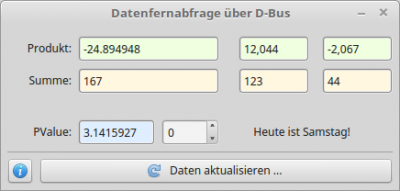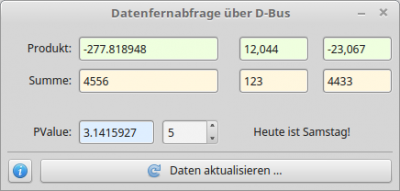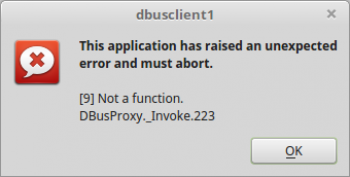Table of Contents
24.9.8.1 Projects - Creating, Exporting and Using a D-Bus Object
In this chapter you will be introduced to, among other things, a Gambas program that implements a D-Bus server that provides a specific service to d-bus enabled programmes. The implemented service provided by a D-bus object exported to the session D-bus can be described like this:
- Calculate and return the product of two real numbers passed as parameters in method call 1.
- Calculate and return the sum of two integers passed as parameters in method call 2.
- Calculate and return the current day of the week as text if the function value WeekDay(Now()) of the data type Integer is passed as a parameter in method call 3.
- Read the value of the property PValue.
- Modify the property PValue. Unfortunately, a bug in the gb.dbus component prevented the value of a property from being changed on a D-Bus server. The error was fixed with https://gitlab.com/gambas/gambas/commit/be3375e0d29022f3e43adcfc38dafee9684060ba.
The error in the gb.dbus component made itself felt like this:
24.9.8.1.1 Project Server
The source code for each D-Bus server that provides a service consists of at least 2 class files. The reason is that the service is implemented in a D-Bus object, which is described in a special class file. You can freely define the name - in this project Service.class. The D-bus object is exported to the session D-bus in the start class FMain.class, so that the service can also be used by other d-bus-capable programmes.
Service
The general rule for a D-Bus service is that all methods are implemented as functions. If the function values are native data types - in this service, integer, float and string - then you do not need to worry about converting Gambas data types to D-bus data types. The conversion is done automatically. Properties are declared in the usual way.
The source code of the class Service.class is pleasantly short and clear:
' Gambas class file Inherits DBusObject ' This instruction is required Create Static ' This instruction is required Property PValue As Float ' Public variable Private $fPValue As Float = Pi() ' Local variable Public Function ComputeAddInteger(Value1 As Integer, Value2 As Integer) As Integer Return Value1 + Value2 End Public Function ComputeMulFloat(Value1 As Float, Value2 As Float) As Float Return Value1 * Value2 End Public Function GetDayOfWeekText(iNumberOfDay As Integer) As String Dim aTagesListe As String[] aTagesListe = [("Sunday"),("Monday"),("Tuesday"),("Wednesday"),("Thursday"),("Friday"),("Saturday")] Return aTagesListe[iNumberOfDay] End Private Function PValue_Read() As Float Return $fPValue End Private Sub PValue_Write(Value As Float) $fPValue = Value End
In the source code of FMain.class, the registration of the D-Bus object in line 12 is the central instruction after a new D-Bus object of type 'Service' has been created in line 3:
[1] ' Gambas class file [2] [3] Public hDBusObject As Service [4] [5] Public Sub Form_Open() [6] [7] FMain.Resizable = False [8] FMain.Caption = ("The data server is activated") [9] DBus.Unique = True [10] [11] hDBusObject = New Service [12] Try DBus.Session.Register(hDBusObject, "/Service") [13] If Error Then [14] Message.Error("An instance of " & Application.Name & " already exists.") [15] FMain.Close() [16] Endif [17] [18] End [19] [20] Public Sub Form_Close() [21] If DBus.IsRegistered(hDBusObject) Then DBus.Session.Unregister(hDBusObject) [22] FMain.Close() [23] End
24.9.8.1.2 Project Client
The source code for the client dbusclient1 is given in full and then commented on:
[1] ' Gambas class file [2] [3] Private $hDBusProxy As DBusProxy [4] Private $sApplication As String [5] Private $sObjectPath As String [6] [7] Public Sub Form_Open() [8] [9] Dim sMessage As String [10] [11] FMain.Resizable = False [12] FMain.Caption = ("Remote data enquiry via D-Bus") [13] Application.MainWindow = FMain [14] [15] $sApplication = "org.gambas.dbusserver1" [16] [17] If Not DBus.Session.Applications.Exist($sApplication) Then [18] sMessage = ("There is no suitable data server on the session bus!") [19] sMessage &= "<center><font color='red'>" [20] sMessage &= ("The program is terminated.") [21] sMessage &= "</font></center>" [22] Message.Warning(sMessage) [23] FMain.Close() [24] Else [25] $sObjectPath = "/Service" [26] $hDBusProxy = DBus[$sApplication][$sObjectPath] [27] GetData() [28] Endif [29] [30] End [31] [32] Public Sub btnGetData_Click() [33] GetData() [34] End [35] [36] Private Sub GetData() [37] [38] Dim i As Integer [39] Dim fF1, fF2 As Float [40] Dim iS1, iS2 As Integer [41] [42] fF1 = Val(txbFactor1.Text) [43] fF2 = Val(txbFactor2.Text) [44] tboxMul.Text = CStr($hDBusProxy.ComputeMulFloat(fF1, fF2)) [45] [46] iS1 = Val(txbSummand1.Text) [47] iS2 = Val(txbSummand2.Text) [48] tboxSum.Text = CStr($hDBusProxy.ComputeAddInteger(iS1, iS2)) [49] [50] i = WeekDay(Now()) [51] lblDOW.Text = $hDBusProxy.GetDayOfWeekText(i) & "!" [52] [53] tboxPValue.Text = Round($hDBusProxy.PValue, -7) [54] [55] End [56] [57] Public Sub sboxChange_Change() [58] [59] Dim fCurValue As Float [60] [61] fCurValue = $hDBusProxy.PValue [62] Try $hDBusProxy.PValue = fCurValue + sboxChange.Value [63] tboxPValue.Text = Round($hDBusProxy.PValue, -7) [64] [65] End [66] [67] Public Sub btnIntrospection_Click() [68] FIntrospection.Show() [69] End [70] [71] Public Sub Form_Close() [72] FMain.Close() [73] End
Comment:
- Line 17 checks whether the application with the D-bus name org.gambas.dbusserver1 exists on the session bus. If this is the case, after the assignment in line 25, a proxy is created in line 26 and consequently only this is used.
- In the procedure GetData(), all three implemented methods are called with the required arguments and the returns (function values) provided by the server are displayed in the provided controls. In addition, the property PValue is also read out and displayed.
- The procedure for changing the value of the PValue property could not be tested yet.
24.9.8.1.3 Use of Server and Client
Server
The server is started, exports a D-bus object to the session D-bus with the implemented service and waits for requests from d-bus capable clients.
The presented client uses the offered service of the server:

Figure 24.9.8.1.3: Calculation 1 with start values

Figure 24.9.8.1.4: Calculation 2
You can change the summands and the factors via input fields. You modify the value for PValue via a SpinBox in integer steps. Afterwards, the product, the sum and the current day name are updated and displayed via three different method calls and the value of the PValue property is read out and also displayed in a text box.
At any time you can get information about the implemented methods, their signature and input parameters as well as about the defined property 'PValue' via an introspection, which is realised by clicking on the i-button:

Figure 24.9.8.1.5: Successful introspection of the object '/Service'.

